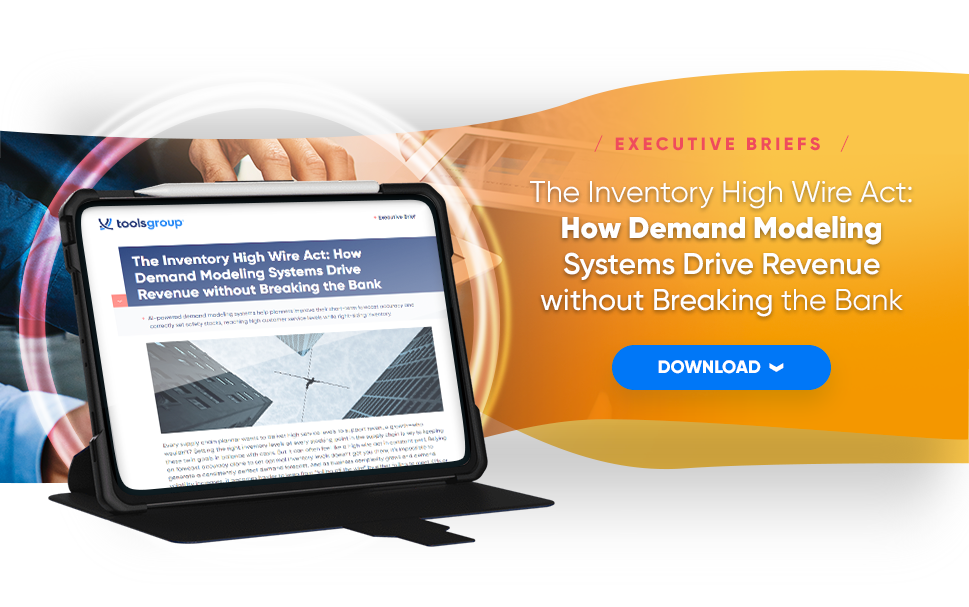Balancing Service Levels and Supply Chain Costs
Editor’s Note: Last year ToolsGroup became Microsoft’s partner for Multi-echelon Inventory Optimization (MEIO) in Industrial accounts. We collaborated on a blog about how to solve the often difficult challenge of balancing service levels with supply chain costs. You can see their version here on the Microsoft website and our slightly abridged version below.
Inventory management has always presented manufacturers with a difficult dilemma—keep enough stock on hand to achieve high customer service levels, or keep inventory costs low and risk missed sales and unhappy customers? Rising customer expectations and an increasingly complex supply chain are making this classic inventory dilemma even more challenging, and many manufacturers are struggling to both satisfy customers and maintain healthy margins.
Two trends have made the classic inventory dilemma of service levels versus costs more difficult: globalization and personalization. First, globalization has put pressure on a dispersed supply chain, increasing complexity and driving down margins. Second, customers are demanding more specialized, tailored products, leading to a growth in the number of finished goods and components that manufacturers must make. Product proliferation has made it harder for manufacturers to achieve high service levels, while growing supply chain complexity has cut into profitability.
Addressing Long Tail Demand
As the supply chain has shifted to keep up with the demand for more personalized products and become more customer-focused, manufacturers must have the right stock in the right place to satisfy service level expectations. Unfortunately, that is an increasingly expensive endeavor, due to demand volatility and the growth “long tail” demand which is more difficult to accurately forecast. The increased complexity and cost of effectively answering the what, when, where, and how much of stock-keeping to attain high service levels hampers businesses who rely on a greater variety of products in the long tail for revenue, and thus must keep more unique components and finished products on hand. These difficulties are amplified by increasingly volatile demand—the number one challenge cited by Chief Supply Chain Officers. As products multiply, volatility becomes more frequent, and sudden sales spikes of specific goods can lead to costly overreactions to meet demand and prevent stock outs.
This problem is especially acute with high-margin products. Manufacturers can ill afford to lose sales of products that offer high margins, as so profit contribution is at stake. To maintain profitability, organizations often compensate by keeping excess inventory across the supply chain. This means paying for, producing, moving, storing, and managing items that may sell slowly or not at all. The inability to accurately forecast this demand forces manufacturers to prioritize addressing volatility and the long tail with excessive inventory.
Controlling inventory expenses often comes at a cost
The other approach is to focus on keeping costs down. Mismanaged, excess inventory is often one of manufacturers’ biggest inefficiencies, tying up working capital through holding costs and obsolescence and significantly harming profits. Worse, the demand for more specialized goods and new product introductions causes inventories to become obsolete, heightening the risks and costs associated with maintaining inventory. Manufacturers must stay lean to compete, and minimizing stock boosts profitability and increases liquidity—eliminating ineffective inventories that are not aligned to profit or customer service goals. Plus, for low-margin products, cutting inventory costs is especially important as there is very little wiggle room for supply chain expenses before these products become detrimental to profitability.
Legacy supply chain planning systems do not provide the insights necessary to individually optimize inventory and service levels for various products, relying on rules-of-thumb and arbitrary segmentation. While keeping stock low based off guesswork or unscientific processes may temporarily minimize operational expenses, there are consequences to customer satisfaction and loyalty plus the logistical challenges and expenses incurred in handling stock out.
Multi-Echelon Inventory Optimization
However, it’s now not necessary to choose exclusively between service levels and costs—it’s possible and even common to enable both high service levels and low operational costs with inventory optimization. This means moving beyond simple tradeoffs between adding inventories to increase service levels or reducing inventory to cut costs.
Multi-Echelon Inventory Optimization optimizes inventory by intelligently analyzing existing data with advanced analytics and balancing inventory across different echelons, locations, bill-of-materials levels, and service level agreements–minimizing costs while maximizing service levels according to the diverse needs of each business. The key to sustainable success is greater inventory efficiency, where every dollar invested in inventory contributes to service levels in the most effective way.
With today’s technology and best practices, manufacturers can achieve higher service levels and lower supply chain costs, with optimization engines that both maximize inventory efficiency and empower organizations to make intelligent decisions to further minimize costs or enhance service.








